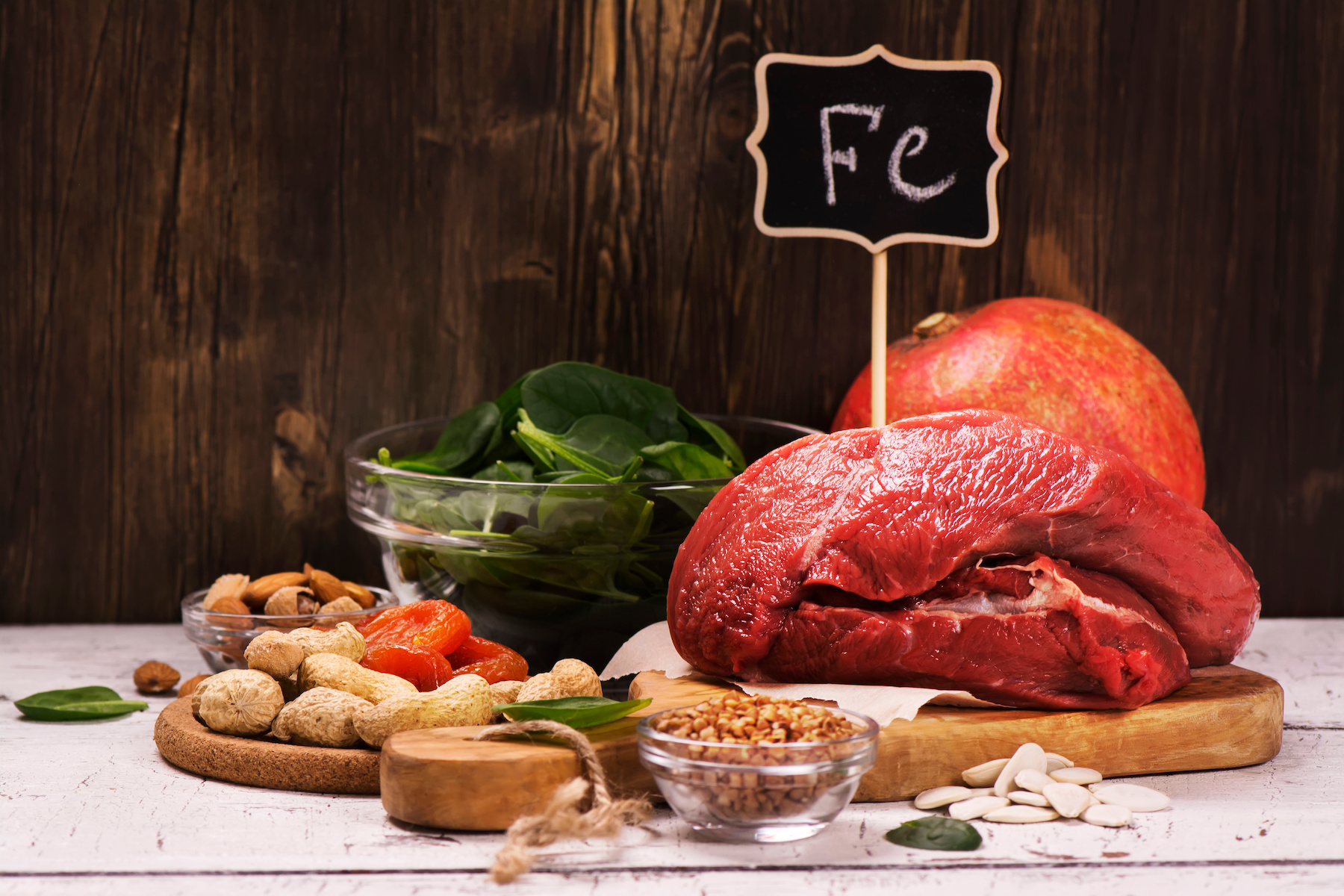

Iron is an essential nutrient for the body – but it’s common to not get enough. So much so that iron deficiency affects 25% of the world’s population! Let’s look closer at the role of iron in the body and how to get enough for optimal health.
The Role of Iron in the Body
Red blood cells transport oxygen throughout the body. Iron’s role is to support the functioning of these healthy red blood cells via hemoglobin, a protein in red blood cells that carries oxygen in the blood. Without enough iron, oxygen isn’t transported effectively.
Common symptoms of iron deficiency include:
- Weakness
- Fatigue
- Shortness of breath
- Pale skin
- Fast heartbeat
- Cold hands and feet
- Headache or lightheadedness
- Unusual cravings for non-food items like ice or dirt
- Brittle nails or hair loss
Testing for Iron in the Body
If you notice symptoms of iron deficiency, your provider will check your iron levels. There are a handful of functional medicine lab tests that do this. Keep in mind that optimal levels may vary depending on your specific diagnosis or condition. Let’s look at each.
Iron or serum iron
This test measures the amount of iron in the blood. A low or high value corresponds with low or high blood iron levels respectively.
Ferritin
Ferritin measures how much iron is stored in the body. As expected, below normal indicates poor iron levels in the body. A high lab value indicates increased iron stored in the body. Ferritin can also be high from inflammatory conditions; thus, it is important to look at the whole iron panel as well as inflammation markers when assessing iron metabolism.
TIBC or total iron-binding capacity
This test measures how well transferrin, a protein in the blood, carries iron in your blood. It shows if you have too much or too little iron in your blood.
Transferrin
This test measures a protein called transferrin, which moves iron throughout the body. It looks to see if you have enough of this protein to support iron in moving via the bloodstream.
What Causes Changes in Your Iron Levels?
A variety of factors can cause either too high or too low iron levels. Let’s look at each.
Low Iron Levels
Bleeding and blood loss
During periods of sustained bleeding, such as injury or heavy menstruation, iron levels need to be restored. If not, iron levels will drop and iron deficiency anemia can develop.
Poor absorption in the GI tract
Normally your GI tract breaks down food and absorbs nutrients. But if it’s not functioning properly, iron isn’t absorbed as well. Individuals prone to poor absorption include those with celiac disease or individuals who had part of their GI tract surgically removed. In these cases, the body can’t absorb as much iron from food, leading to a potential deficiency over time.
Lack of iron in your diet
Since our bodies don’t make iron, we must get it through food sources. When this isn’t achieved, deficiency is more apt to happen.
Pregnancy
Lastly, pregnancy can lead to a decrease in iron levels in the body. During pregnancy, the total volume of the mother’s blood increases, so more iron is needed for the blood to do its job, plus the growing fetus also needs iron as well. This is why an iron supplement is usually recommended during pregnancy and is part of most prenatal vitamins.
High Iron Levels
While not as common as deficiency, having too much iron is possible. When iron is too high, it’s stored in your organs and oxidation occurs. This can cause complications like diabetes, heart problems, inflammation/immune dysfunction or liver disease. The treatment for high iron is phlebotomy or donating blood. This helps remove the excess iron.
Too much iron can occur from genetic conditions such as hemochromatosis or from taking too many nutritional supplements or getting too much iron in the diet. Too much iron has the potential to negatively affect your health which is why you want to avoid supplementing with it unless your blood levels are being monitored. Thus, working with a functional medicine provider, you trust is important to help guide you. They can look at your unique body and create an individualized plan for you if you have high or low iron levels.
How to Get Enough Iron
The easiest way to get enough iron is through food. Foods sources of iron include:
- Organ meats (especially liver and spleen)
- Red Meat
- Dark green leafy vegetables
- Beans and lentils
- Olives
One thing to know is animal sources are absorbed better than plant sources. But there are still plenty of non-meat sources that contain iron. If you don’t eat meat, focus on eating a variety of dark green leafy vegetables, beans, lentils, nuts, and seeds. Eating a vegetarian source of iron with vitamin C – like citrus fruit – can help improve absorption. So even if you don’t eat meat, you can still get iron.
Some foods say they are “fortified with iron”. While iron is added to these foods, they aren’t as ideal as the iron found naturally in foods. Focus on getting your iron intake from real food and less on these iron-fortified foods.
But iron can enter the body in other ways too! Cast iron pans are a great source of iron when used for cooking. Supplementation may also be part of the functional medicine treatment plan for those with documented low iron. While dietary sources of iron are preferred, supplementation may be needed in some cases. Here’s a great one to try that is friendly to the GI tract. It is always best to take iron supplements with food to avoid nausea. In addition, iron may interfere with absorption of certain medications, and should be taken 4 hours apart ideally.
Optimal Health with Functional Medicine!
If you’re struggling with extreme fatigue, tiredness, or shortness of breath, iron deficiency may be to blame. At Arizona Wellness Medicine, our team of highly trained functional medicine providers help you reach optimal health. We want you to feel your best, which is why we create an individualized plan that’s right for you. Get in touch here to make your first appointment.
Resources:
https://pubmed.ncbi.nlm.nih.gov/18498676/
https://www.mayoclinic.org/diseases-conditions/iron-deficiency-anemia/symptoms-causes/syc-20355034
https://www.mayoclinic.org/diseases-conditions/iron-deficiency-anemia/symptoms-causes/syc-20355034
https://medlineplus.gov/lab-tests/iron-tests/
https://www.uptodate.com/contents/image?imageKey=HEME%2F76236&topicKey=PEDS%2F5350&source=see_link
Share:
Dr. Emily Parke
Social Media
Most Popular Posts
Subscribe To Our Newsletter
Related Posts

Estrogen Metabolism: How It Works, Why It Matters, and Supplements for Healthy Estrogen Metabolism
Estrogen metabolism is vital to estrogen regulation. Learn how it works and how the DUTCH test can provide insight into hormonal imbalance.

The Paleo Diet Versus the Autoimmune Paleo Diet: Differences and Benefits
Learn the difference between the paleo and the autoimmune paleo diet, including food lists, what foods to avoid, and all the health benefits!

A Complete View of Multiple Sclerosis: Symptoms, Diagnosis, and Functional Medicine Treatment Options
Get a complete view of multiple sclerosis, including common symptoms and treatment options, including nutrition and supplementation.

Headaches and How to Find Relief: The Functional Medicine Way
Learn about functional medicine headache treatment, various headache types, and how to achieve lasting relief with complementary approaches.
